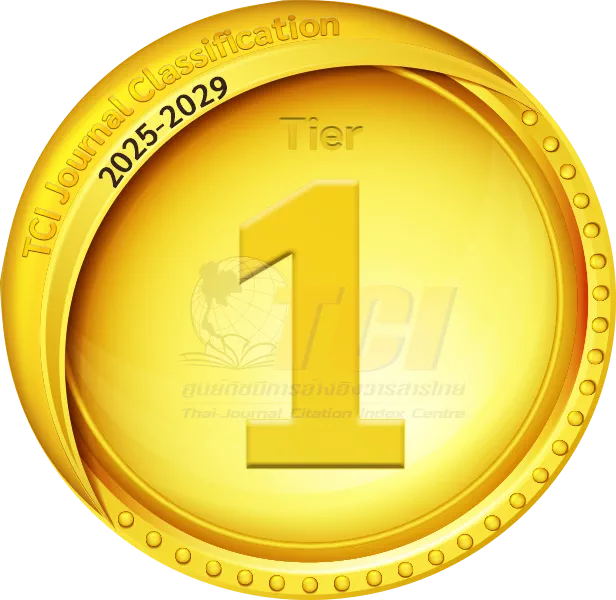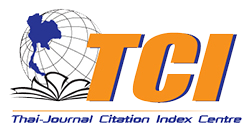การศึกษาประสิทธิภาพของเครื่องฟอกอากาศราคาประหยัดที่ใช้ไมโครคอนโทรลเลอร์และแผ่นกรองใช้ซ้ำในการปรับปรุงคุณภาพอากาศ
A Study on the Efficiency of a Low-Cost Air Purifier Using a Microcontroller and Reusable Filters for Air Quality Improvement
Abstract
บทความนี้ได้นำเสนอการศึกษาปริมาณ PM2.5 PM10 และปริมาณสารประกอบอินทรีย์ระเหยง่าย (TVOC) ที่ถูกขจัดโดยเครื่องฟอกอากาศราคาประหยัดที่ประดิษฐ์ขึ้น (LCAP) ซึ่งทำการเปรียบเทียบประสิทธิภาพในการกรอง และอัตราการส่งอากาศบริสุทธิ์ (CADR) จากแผ่นกรองปกติและแผ่นกรองที่นำกลับมาใช้ใหม่ของ LCAP กับเครื่องฟอกอากาศที่นิยมใช้งาน 2 แบบ (AP_1 และ AP_2) ในห้องทดสอบขนาด 126 ลบ.ม. ผลการทดสอบของ LCAP ที่ใช้แผ่นกรองแบบ Anti-bacteria ปกติ (LCAP_B) พบว่า สามารถขจัด PM2.5 และ PM10 ได้ใกล้เคียงกับ AP_2 แต่แผ่นกรองแบบ Formaldehyde (LCAP_F) นั้นสามารถขจัด TVOC ได้ดีกว่า AP_2 โดย LCAP_B สามารถขจัด PM2.5 และ PM10 จากระดับคุณภาพอากาศที่เป็นอันตราย (ประมาณ 700 ไมโครกรัม/ลบ.ม.) ให้อยู่ในระดับที่ดีมากได้ในระยะเวลา 82 และ 62 นาที ตามลำดับ สำหรับการนำแผ่นกรองกลับมาใช้ใหม่ของเครื่องฟอกอากาศราคาประหยัดสามารถขจัด PM2.5 PM10 และ TVOC ได้ดีกว่า AP_2 พบว่า แผ่นกรองที่ทำความสะอาดด้วยเครื่องดูดฝุ่นและเครื่องเป่าลม (LCAP_BCV) สามารถขจัด PM2.5 PM10 และ TVOC ได้ดีกว่าแผ่นกรองที่สกปรก (LCAP_BD) เพียงเล็กน้อยประมาณ 0.38% 0.34% และ 1.79% ตามลำดับ แผ่นกรองที่ทำความสะอาดด้วยผงซักฟอก (LCAP_BCD) สามารถขจัด TVOC ได้ดีกว่า LCAP_BD และ LCAP_B ประมาณ 26.44% และ 21.01% ตามลำดับ แต่ LCAP_BCD สามารถขจัด PM2.5 และ PM10 ได้ต่ำกว่า LCAP_BD ประมาณ 5.96% และ 5.73% ตามลำดับ และการทำงานร่วมกันของ LCAP สามเครื่อง (LCAP_T) สามารถขจัด PM2.5 และ PM10 ให้อยู่ในระดับคุณภาพอากาศที่ดีมากได้ในระยะเวลา 36 และ 28 นาที ตามลำดับ ข้อดีของ LCAP ที่ดีกว่า AP_1 และ AP_2 คือ มีแบตเตอรี่ภายในตัว และทำงานร่วมกันแบบ Master-Slave โดย LCAP-Slave นั้นไม่จำเป็นต้องมีเซ็นเซอร์ตรวจจับมลพิษ
This study investigates the removal efficiency of PM2.5, PM10 and Total Volatile Organic Compounds (TVOC) using a Low-cost Air Purifier (LCAP). The filtration efficiency and Clean Air Delivery Rate (CADR) of both standard and reusable filters in the LCAP were compared with those of two popular air purifier models (AP_1 and AP_2) in a 126 m³ test chamber. The test results indicate that the LCAP equipped with a standard antibacterial filter (LCAP_B) removes PM2.5 and PM10 at a level comparable to AP_2, while the LCAP equipped with a formaldehyde filter (LCAP_F) exhibits superior TVOC removal efficiency compared to AP_2. Specifically, LCAP_B reduces PM2.5 and PM10 from hazardous levels (approximately 700 μg/m³) to an excellent air quality level within 82 and 62 minutes, respectively. For reusable filters, the results show that LCAP outperforms AP_2 in removing PM2.5, PM10, and TVOC. The filter cleaned with a vacuum cleaner and blower (LCAP_BCV) demonstrates a slight improvement in removal efficiency over the dirty filter (LCAP_BD), with increases of approximately 0.38%, 0.34%, and 1.79% for PM2.5, PM10, and TVOC, respectively. The filter cleaned with detergent (LCAP_BCD) improves TVOC removal by approximately 26.44% and 21.01% compared to LCAP_BD and LCAP_B, respectively. However, LCAP_BCD is less effective in removing PM2.5 and PM10 than LCAP_BD, with reductions of approximately 5.96% and 5.73%, respectively. Furthermore, the combined operation of three LCAP units (LCAP_T) achieves excellent air quality levels, reducing PM2.5 and PM10 within 36 and 28 minutes, respectively.The advantages of LCAP over AP_1 and AP_2 include an internal battery and a Master-Slave operation, where LCAP-Slave units do not require pollution sensors.
Keywords
[1] Ministry of Public Health. (2023, Jan.). Operation manual of medicine and public health in case of PM2.5 in 2023. [Online] (in Thai). Available: https://multimedia.anamai.moph.go.th/ associates/ebook/.
[2] S. Limptosuwan, A. Praphanphat, V. Tanwandee, P. Raiubsr, and P. Hirunkitti, “Factors affecting Bangkokers’ decision to purchase air purifiers,” Journal of Value Chain Management and Business Strategy, vol. 2, no. 1, pp. 1–13, Jan. – Mar. 2023 (in Thai).
[3] Y. Piladee and S. Rattanadilok Na Phuket, “Stains removal efficiency and foam characteristic of liquid detergents by using different surfactant ratios,” in Proceedings of 60th Kasetsart University Annual Conference, vol. 60, pp. 510–517, 21–23 Feb. 2022 (in Thai).
[4] A. Deephang, C. Addoddorn, and T. Aekkuerkul, “The design and construction of automatic 3 speed level mobile air filter controlled by microcontroller,” Udon Thani Rajabhat University Journal of Sciences and Technology, vol. 10, no. 3 pp. 63–79, Sep.–Dec. 2022 (in Thai).
[5] K. Donchai, “Development of a dust filter PM2.5 version 4 of Chiangrai Technical College,” Vocational Education Innovation and Research Journal, vol. 6, no. 2, pp. 11–22, Jul.–Dec. 2022 (in Thai).
[6] T. Sanhan, J. Dikae, and C. Panyindee, “Small low-cost air purifier controlled by an android smartphone,” NBTC Journal, vol. 5, no. 5, pp. 319–333, Dec. 2021 (in Thai).
[7] V. Asanavijit, P. Intra, W. Rattanachan, and P. Hansapiromchoke, “Evaluation of the filtration efficiency of aerosol particles of the commercial air purifiers for indoor use,” Ladkrabang Engineering Journal, vol. 38, no. 4, pp. 11–22, Dec. 2021 (in Thai).
[8] H. J. Kim, B. Han, C. G. Woo, Y. J. Kim, G. T. Lim, and W. G. Shin, “Air cleaning performance of a novel electrostatic air purifier using an activated carbon fiber filter for passenger cars,” IEEE Transactions on Industry Applications, vol. 53, no. 6, pp. 5867–5874, Nov.–Dec. 2017.
[9] Sharp Corporation. (2011, Jun.). Sharp FU-A28TA air purifier operation manual.[Online] (in Thai). Available: https://www. sharpthai.co.th/backoffice/img/download_ center/th/FU-A28TA.pdf.
[10] Beijing Smartmi Electronic Technology Co., Ltd., Beijing, China. (2020, Sep.). Mi air purifier 3H user manual. [Online]. Available: https://fcc. report/FCC-ID/2AP98-ACM6SC/491 8506.pdf.
[11] T. Zheng, M. H. Bergin, K. K. Johnson, S. N. Tripathi, S. Shirodkar, M. S. Landis, R. Sutaria, and D. E. Carlson, “Field evaluation of low-cost particulate matter sensors in highand low-concentration environments,” Atmospheric Measurement Techniques, vol. 11, no. 8, pp. 4823–4846, 2018.
[12] G. Yurko, J. Roostaei, T. Dittrich, L. Xu, M. Ewing, Y. Zhang and G. Shreve, “Real-time sensor response characteristics of 3 commercial metal oxide sensors for detection of BTEX and chlorinated aliphatic hydrocarbon organic vapors,” Chemosensors, vol. 7, no. 3, Sep. 2019.
[13] V. Rachnarong, “A study of air quality effect by creating a device detect PM2.5, TVOC and CO2-eq,” Journal of Engineering and Digital Technology, vol. 9, no. 2, pp. 37–48, Jul.–Dec. 2021 (in Thai).
[14] T. Hanond, Y. Chantarasuk, S. Puangpan, N. Waropastrakul, S. Wongwajana, R. Sermswan, and S. Wongratanacheewin, “Efficacy of ion generator against bacteria and fungi,” Srinagarind Medical Journal, vol. 26, no. 4, pp. 302–308, Jul.–Aug. 2011 (in Thai).
[15] V. Rachnarong, “Performance evaluation of low-cost particulate matter sensors for PM2.5 and PM10 measurement,” Engineering and Technology Horizons, vol. 40, no. 3, 2023 (in Thai).
[16] The Household Air Cleaner, Japan Electrical Manufacturers Association Standard 1467, 1995.
[17] Method for Measuring Performance of Portable Household Electric Room Air Cleaners, ANSI/ AHAM AC-1-2006, Association of Home Appliance Manufacturers Washington, D.C., USA, 2006.
[18] Air Quality and Noise Management Bureau. (2023, May 16). Thailand's air quality Information in 2023. Pollution Control Department, Bangkok, Thailand. [Online] (in Thai). Available: https:// www.pcd.go.th/wp-content/uploads/2023/06/ pcdnew-2023-06-02_09-43-56_071099.pdf.
[19] C. Meyer, (2024, Jan.). Overview of TVOC and Indoor Air Quality. Renesas Electronics Corporation. [Online]. Available: https://www. renesas.com/us/en/document/whp/overviewtvoc- and-indoor-air-quality.
DOI: 10.14416/j.kmutnb.2025.03.004
ISSN: 2985-2145





